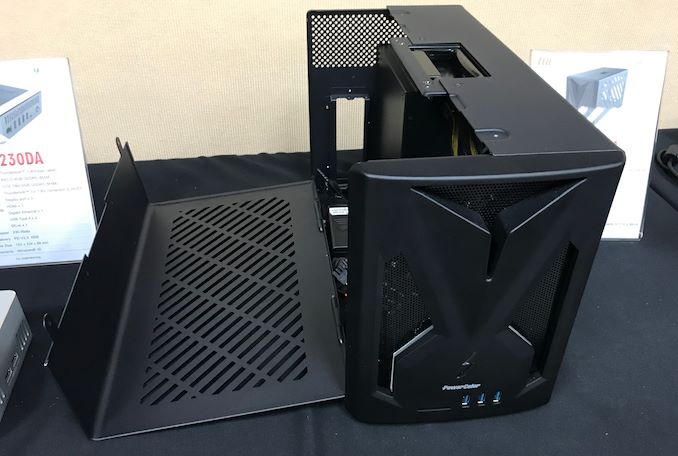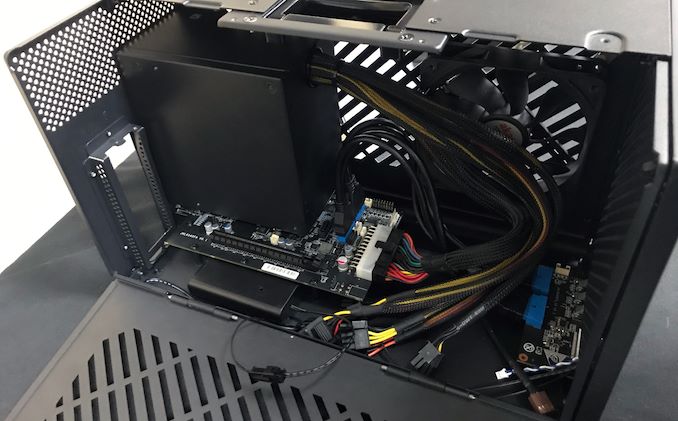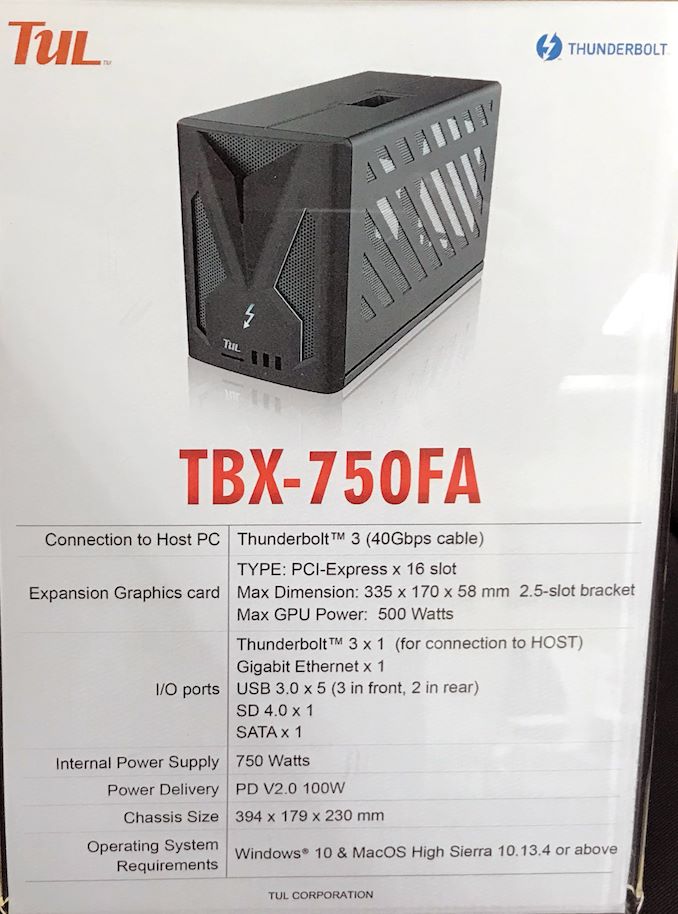PowerColor's External Behemoth: The 750 Watt TBX-750FA eGFX Box, With 100 W Power Delivery
by Anton Shilov on June 20, 2019 8:00 AM EST- Posted in
- GPUs
- PowerColor
- Trade Shows
- Thunderbolt 3
- eGFX
- TUL
- Computex 2019

Tul, the parent company of PowerColor, currently has two external graphics (eGFX) boxes for high-end graphics cards, as well as low-power miniature eGFX solutions. Both sides of the coin have allowed the company to gain a lot of experience when it comes to external Thunderbolt 3 graphics. At this year's Computex, the company demonstrated its upcoming enclosure for high-performance customers that will offer even more advantages over their previous-gen chassis.
The TBX-750FA eGFX box is equipped with a 750 W power supply, which allows it to deliver up to 500 W of power to a graphics card as well as up to 100 W of power to its host laptop via USB-PD. With 500 W of power available to a video card, the chassis will be compatible even with the highest-performing video card, with a good bit of headroom to spare for overclocking. Furthermore, the box will be able to power high-end 15.6-inch laptops.
Traditionally for Tul, and PowerColor, the TBX-750FA eGFX box supports loads of additional capabilities. In particular, the unit has a 2.5-inch SATA bay, a GbE port, an SD 4.0 card reader, as well as five-port USB 3.0 hub.
The TBX-750FA can house a 2.5-slot wide graphics card and integrates a standard power supply along with multiple additional components, which makes the chassis rather bulky.
At Computex, Tul demonstrated its TBX-750FA eGFX enclosure under its own brand, which means that the chassis will be available not only to PowerColor, but to other suppliers of eGFX products too. It is hard to say when this product is set to be available from any brand, but at Computex the company demonstrated a pre-production sample.
Related Reading:
- Exploring Thunderbolt 3 eGFX Performance, Feat. PowerColor's Gaming Station & Radeon RX Vega 56 Nano
- CES 2019: PowerColor & VisionTek Launch Compact eGFX Solutions
- PowerColor Announces Gaming Station: The Devil Box’s Spawn, TB3 eGFX Enclosure
| Want to keep up to date with all of our Computex 2019 Coverage? | ||||||
 Laptops |
 Hardware |
 Chips |
||||
| Follow AnandTech's breaking news here! | ||||||














18 Comments
View All Comments
AdditionalPylons - Thursday, June 20, 2019 - link
Three questions:1. Many vendors now include multiple connectors such as storage and networking in eGPU cases, but they still only use one TB3 connector. How does the GPU handle the varying performance load from these other devices? Does it get dedicated static bandwidth assigned over PCIe or is it dynamic depending on the non-GPU devices' load?
2. A back-of-the-envelope calculation of theoretical bandwidth used by SATA, GbE and USB3.0 (assuming one bus with shared bandwidth over all 5 ports) I get 6+1+5+3=15 Gbps. This leaves roughly 40-15=25 Gbps for the GPU. This seems like a pretty tough limitation, potentially neglecting the point of putting a powerful GPU in this box. Why wouldn't they rather go for a GPU only solution, or add a second TB controller for the non-GPU devices? Or am I missing something here?
3. Are there any news on whether AMD will implement TB3? I'm mainly concerned about laptops, as in desktop machines we can always buy the Gigabyte GC-Alpine Ridge add-in card.
TheUnhandledException - Thursday, June 20, 2019 - link
If it is anything like all existing eGPU enclosures the GBe and the SATA port as are just off the usb hub. That means it is is just 5 Gbps (or 10 Gbps in the case of usb3.1) reserved for the ports and the rest for the GPU.A few enclosures use a second TB3 controller to run all the ports that way the GPU has the full bandwidth but based on the specs I don't think that is the case here.
Skeptical123 - Monday, June 24, 2019 - link
So I went down a little bit of a rabbit hole looking this up."In the Thunderbolt mode, Thunderbolt 3 port has the ability to support at least one or two (4 lane) DisplayPort interface(s), and up to 4 lanes of PCI Express Gen 3" and lists USB Only Mode
DisplayPort Only Mode - a single four lane (4 x 5.4 Gbps, or HBR2) link of DisplayPort
DisplayPort and USB Mulit-Function Mode - one of the high speed connector pin pairs of signals will be dedicated to DisplayPort (now 2 lanes at 5.4 Gbps) and one to USB 3.1 This allows for a basic connectivity for data and display devices such as docking stations or data and display dongles.
Thunderbolt 3 Mode - If a cable and device supporting it... the Thunderbolt silicon activates its highest capability mode and config- ures four high-speed links at either 10 Gbps or 20 Gbps (depending on cable and device support) to support the Thunderbolt transport. This provides bidirectional data rates of 20 or 40 Gbp."
"Additionally, to fill this Thunderbolt link, the silicon extracts and routes up to 4 lanes of PCI Express Gen 3(4 x 8 Gbps) and up to two full (4 lane) links of DisplayPort out over the Thunderbolt cable and connector to the device(s) attached downstream from the host system."
How these lanes are divided up depends on the the first device plugged into the host. It's safe to assume a solution like this will use the full thunderbolt spec and probably have all 4 lanes of the PCIe bus the to PCIe x16 slot and use the 4 remain pins for the rest of the io.
jordanclock - Thursday, June 20, 2019 - link
For both 1 and 2, GPUs actually don't use as much bandwidth as you might be under the impression they use and even then it really depends on the game.https://www.techpowerup.com/review/nvidia-geforce-...
Overall the GPU will just have to deal with having variable data rates, but I don't think it will have that big of an impact. The scenario you pointed out of having max utilization of all ports is extremely unlikely and those that would run into those scenarios are likely to be using a separate dock and TB/USB interface for those purposes.
Meaker10 - Friday, June 21, 2019 - link
TB3 controllers hang off the chipset on mainstream platforms. Having a 2nd controller would not improve overall bandwidth as the chipset is limited to the same amount ,(basically 4x pcie 3.0)jenesuispasbavard - Thursday, June 20, 2019 - link
Any word on price? Hopefully this is an interesting alternative to the Razer Core X Chroma which is $400. That enclosure though has two Thunderbolt 3 controllers, one exclusively to handle the GPU and the other for USB+ethernet. I wonder if this is the same.Flunk - Thursday, June 20, 2019 - link
That's the important question here. Similar products exist already, so is this cheaper than those?sorten - Thursday, June 20, 2019 - link
I like the 100W PD, but 500W for the GPU is more than double the power needed for the 2080ti. Even last gen AMD GPUs don't use that much power.mischlep - Thursday, June 20, 2019 - link
Remember that power supplies hit their peak efficiency levels between 40 and 80% of supported capacity. Having the capacity for double the power of the video card sounds about right.Flunk - Thursday, June 20, 2019 - link
Also, they pretty much don't make decent quality power supplies under 450W anymore.